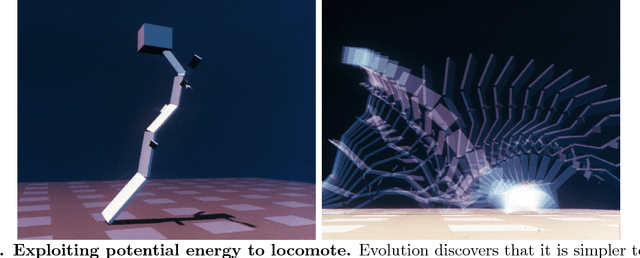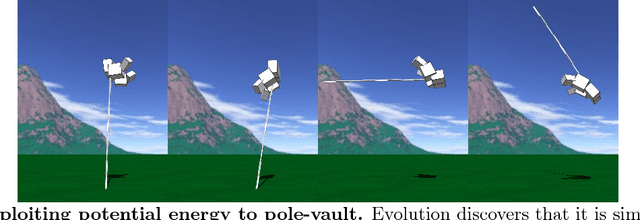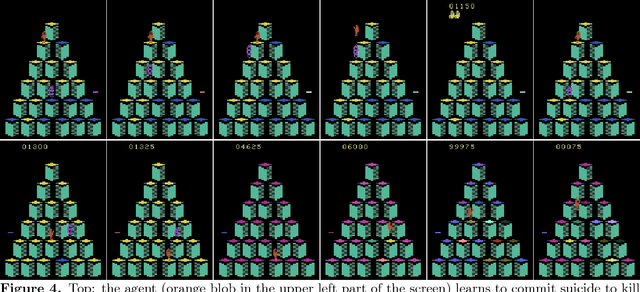Patryk Chrabaszcz
The Surprising Creativity of Digital Evolution: A Collection of Anecdotes from the Evolutionary Computation and Artificial Life Research Communities
Aug 14, 2018



Abstract:Biological evolution provides a creative fount of complex and subtle adaptations, often surprising the scientists who discover them. However, because evolution is an algorithmic process that transcends the substrate in which it occurs, evolution's creativity is not limited to nature. Indeed, many researchers in the field of digital evolution have observed their evolving algorithms and organisms subverting their intentions, exposing unrecognized bugs in their code, producing unexpected adaptations, or exhibiting outcomes uncannily convergent with ones in nature. Such stories routinely reveal creativity by evolution in these digital worlds, but they rarely fit into the standard scientific narrative. Instead they are often treated as mere obstacles to be overcome, rather than results that warrant study in their own right. The stories themselves are traded among researchers through oral tradition, but that mode of information transmission is inefficient and prone to error and outright loss. Moreover, the fact that these stories tend to be shared only among practitioners means that many natural scientists do not realize how interesting and lifelike digital organisms are and how natural their evolution can be. To our knowledge, no collection of such anecdotes has been published before. This paper is the crowd-sourced product of researchers in the fields of artificial life and evolutionary computation who have provided first-hand accounts of such cases. It thus serves as a written, fact-checked collection of scientifically important and even entertaining stories. In doing so we also present here substantial evidence that the existence and importance of evolutionary surprises extends beyond the natural world, and may indeed be a universal property of all complex evolving systems.
Back to Basics: Benchmarking Canonical Evolution Strategies for Playing Atari
Feb 24, 2018



Abstract:Evolution Strategies (ES) have recently been demonstrated to be a viable alternative to reinforcement learning (RL) algorithms on a set of challenging deep RL problems, including Atari games and MuJoCo humanoid locomotion benchmarks. While the ES algorithms in that work belonged to the specialized class of natural evolution strategies (which resemble approximate gradient RL algorithms, such as REINFORCE), we demonstrate that even a very basic canonical ES algorithm can achieve the same or even better performance. This success of a basic ES algorithm suggests that the state-of-the-art can be advanced further by integrating the many advances made in the field of ES in the last decades. We also demonstrate qualitatively that ES algorithms have very different performance characteristics than traditional RL algorithms: on some games, they learn to exploit the environment and perform much better while on others they can get stuck in suboptimal local minima. Combining their strengths with those of traditional RL algorithms is therefore likely to lead to new advances in the state of the art.
A Downsampled Variant of ImageNet as an Alternative to the CIFAR datasets
Aug 23, 2017



Abstract:The original ImageNet dataset is a popular large-scale benchmark for training Deep Neural Networks. Since the cost of performing experiments (e.g, algorithm design, architecture search, and hyperparameter tuning) on the original dataset might be prohibitive, we propose to consider a downsampled version of ImageNet. In contrast to the CIFAR datasets and earlier downsampled versions of ImageNet, our proposed ImageNet32$\times$32 (and its variants ImageNet64$\times$64 and ImageNet16$\times$16) contains exactly the same number of classes and images as ImageNet, with the only difference that the images are downsampled to 32$\times$32 pixels per image (64$\times$64 and 16$\times$16 pixels for the variants, respectively). Experiments on these downsampled variants are dramatically faster than on the original ImageNet and the characteristics of the downsampled datasets with respect to optimal hyperparameters appear to remain similar. The proposed datasets and scripts to reproduce our results are available at http://image-net.org/download-images and https://github.com/PatrykChrabaszcz/Imagenet32_Scripts
 Add to Chrome
Add to Chrome Add to Firefox
Add to Firefox Add to Edge
Add to Edge